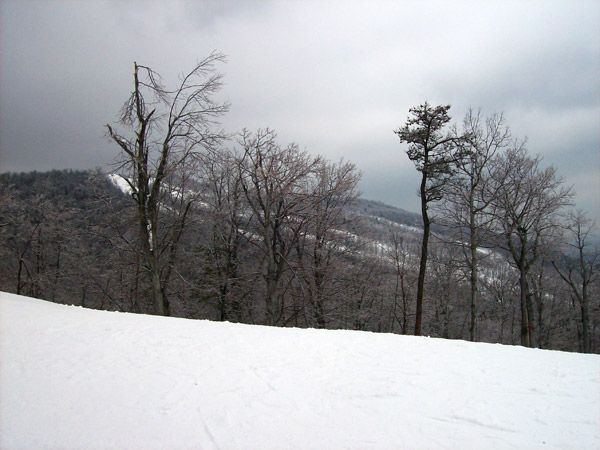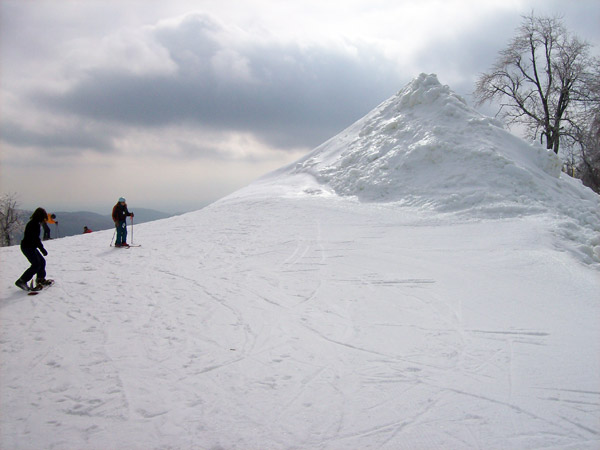Firsthand Report: Whitetail Resort on Groundhog Day
6
Groundhog Day is said to be the favorite day of all the Whitetail staff. They know it usually guarantees six more weeks of winter. One of the staff members even wrote a poem, saying, “Whitetail Wil knows - there’s six more weeks of winter snows.”
Unfortunately, with snow sometimes comes ice. Whitetail and much of the mourtain area was hit with an ice storm on February 1, 2008 (the torrential rain we had in DC was ice, not snow, in the resort areas. Phil - you could have done better!)
|
|
|
Trees were coated with a thin layer of ice on February 2, 2008 at Whitetail Resort. Photo provided by Charles Sneiderman.
|
The forests around Whitetail glistened with ice, and the effect was breathtaking! Trying to navigate down the hard pack also took your breath away, but most people made it.
Whitetail worked hard to groom and break up the crust. But the promised “loose granular” never really materialized, and it was tough going. Sunday looked beautiful - warm and sunny. I am certain it was a perfect day, and I rejoice for all who were able to make it to the mountains on Sunday.
All in all, it could have been worse. Charles and I stuck to the easiest runs, which appeared to be in better shape. We made it down safely, as did most of the people around us. It is work and good exercises for your legs and heart! I was able to turn a lot and did not fall on the hard stuff. But there was no absolute assurance I could stop when I wanted to, and many around me appeared to have the same problem.
Safety concerns
My poor excuse for skiing on slick conditions caused me to reflect again on safety issues - a major concern of mine. I still believe the most dangerous part of snow sports is driving on the highways to get there - that is why I have long advocated more shuttle bus services. The second most dangerous part is a lot of skiers and snowboarders going fast, in all directions, in crowded areas. This is not just confined to the East; the West also can become very crowded, especially on weekends.
|
|
|
Whitetail stockpiles snow at the top of the Whitetail Express, which is used to patch up thin spots in leaner times. Photo provided by Charles Sneiderman.
|
I have seen too many collisions and near misses on crowded slopes. There must be some way to make the sport safer - especially on bottleneck areas where many of the younger set are zooming straight down to get to the terrain parks. One suggestion - could signs be put up, keeping terrain park-goers on one side of the slope? Safety patrols could reinforce the rules. If someone has to cross to the other side, perhaps downhill skiers could be stopped for a few minutes, so others could go across the slope? It is like having traffic lights at intersections, without the lights.
Another suggestion is utilizing small rope lifts or magic carpets up to the terrain parks, so the people using them would not have to come down from the top of the mountain.
Maybe reckless skiers or boarders could be asked to pay for insurance policies, if they do not lose their lift tickets all together? That might induce them to act with greater concern and responsibility.
I offer suggestions because I love the mountains and snow sports so much, and want to make them as safe as possible. I welcome other suggestions - let’s get a dialogue going here!
Adaptive Skiing at Whitetail
While we were at Whitetail, we were delighted to see a number of superb adaptive skiers on the slopes. Many came over from Liberty and Roundtop; Whitetail is working hard to build up its own program. My friend and neighbor, Trippie Penland, was teaching people in her usual enthusiastic, energetic way. She was joined by a number of instructors, including George Hergenhahn, Chief Financial Officer of Special Olympics Maryland. They teach a number of snow sports, including sit-skiing, downhill, cross country, and snowshoe. They also have a lot of fun activities to raise funds, since they get very little government funding, and want the athletes to be able to participate free of charge.
We also met a charming and dynamic ski instructor from Whitetail, Bill Dietrich, who is building up the adaptive program there. He welcomes help and contributions for the program, and can be contacted at wtadaptive@skiwhitetail.com. His program has the able support of ski school director, Mac Jackson, and is planning to work with Disabled Sports USA, based in Rockville.
There is so much going on in the mountains, and so many great things to come. Let’s keep them thriving, and safe, for all of us!
Connie,
I agree with you completely on safety concerns, and a lot of it seems to be a lack of compassion for other human beings. Whether on the Beltway, or the WOD Trail on a crowded weekend, it seems like a lot of people lack basic consideration. This week I was shocked by people listening to IPODS and phones while skiing, and am sure text messaging will be coming to a mountain near all of us soon.
I like the idea of aggressive ski patrols, who will enforce and kick out violators who make resorts unsafe. Permanent ban lists would be a good thing as well.
M.Ethan Ross
Anecdotally, I've noticed that ski areas in the Mid-Atlantic seem to be less aggressive at actively patrolling than they were a decade ago. (There are exceptions: Liberty has made a strong effort in recent years to improve safety on the slopes.)
Ski patrollers have always walked a fine line between customer service and safety enforcement (with the two roles often competing with each other), but I just seem to remember patrollers being much more proactive about issuing warnings and yelling at people when they are skiing/boarding out of control. Now they seem to take more of a back seat approach. Am I imagining this? (I'm sure there are some patrollers here who will take objection, and I don't ski at every resort, so it might not be fair to generalize.) If there is less active enforcement, is it because there's concern about alienating customers? A cutback in the number of patrollers? Or what?
I think we can all point out slopes at our favorite resorts that become very dangerous on Friday nights or weekends, with crazy skiers or boarders flying down at ridiculous speeds regardless of slope conditions or crowds. It's often a small handful of people doing this, and I don't understand why patrollers don't yank their tickets and send them packing.
The last time I was at Vail (2 years ago or so), I was very impressed by how many patrollers were posted along popular trail arteries leading down to the base area around closing time. There were one or two patrollers at each and every turn (I counted over 30 on the way down), and they were definitely pointing out if they thought people were going too fast. Sure, this caused some skiers to grouse, but I think the majority appreciated it, and there's no question it cut down on accidents.
Thank you Scott and Ethan. Let's get a dialogue going about this issue. Now I am mourning the death of my friend, former ABC correspondent John McWethy, who died last week in Keystone. The Washington Post says "he died Feb 6 from blunt force chest injuries suffered in a skiing accident at Keystone."
I don't know how we can make the sports and the mountains we love safer, but we must certainl try. I welcome all suggestions and comments!
Around these parts the slopes I find most dangerous are crowded, steep groomers and busy beginner areas; speeders on the former, out of controllers on the latter. It's definitely not fun to be on the slopes with the feeling you've got a bullseye painted on your back!
Like driving on the Capital Beltway, sometimes it's safest on busy ski trails to keep pace with or go slightly faster then the flow of traffic. But I know this is not always possible if the speeders are doing 90mph. Choosing a mellow ski area or trail pod in the first place can help those who want a safer environment.
I just started wearing a helmet this season after 40 yrs of skiing. Most compelling reason for me was protection in the event of someone plowing into me from a blind side just when I'm thinking everything is under control.
The steepest, bumpy trails are usually not as risky for collisions because of fewer and more skilled skiers. Additionally, the bumps tend to slow down the not-so-skilled that tangle with them.
Of my local visits in recent years I think the most active/visible Ski Patrol I've seen was at the "new" Hidden Valley in Jan 2008.
Thanks Connie for your article. Being a fairly new skier I appreciated your comments about the ice. The last couple of weeks I have felt like my skills were moving in reverse as I dealt with icy conditions.
As for safety in general, there are just too many types of users on too few trails. With the less than optimal weather conditions resorts have had limited terrain open making the situation even worse. Cold weather and snow would help a lot!
The mad bombers are not the only issue...anything that narrows the way down increases the chances of collision. People sitting or laying in the trails is certainly an issue. Another issue is people who fall and then pop back up without a care for what is coming at them from uphill. You either have to slam on the brakes or try to guess where they will go.
I think more aggressive patrolling would definitely help, but some of it needs to be coaching and traffic control.
Thank you Jim and GRK - really appreciate your comments. I love the mountains, but don't like the idea of a mid slope (or highway) crash. Enjoy and be safe! Yours, Connie


